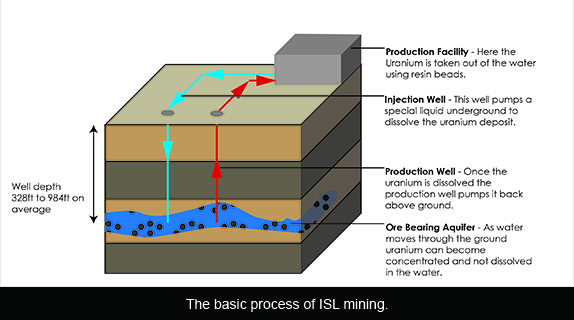On the 19th of October, 2014, the U.S. government had paid out $1.96 Billion to citizens who suffered death or illness from uranium mining, milling, transporting and fallout from nuclear testing. Between that day and February 8th, 2015 payouts from the Radiation Exposure Compensation Act averaged $294,600 per day. At this rate, the total payouts reached $2 Billion on March 3rd, 2015. If a recent United State Geological Survey is any indication, the prospect of new uranium mining in New Mexico could lead to yet more contamination and illness.
Uranium mining, milling, weapons production and waste storage have become intertwined with New Mexico’s history. From the Grants mineral belt to Los Alamos National Laboratory, where the greatest weapons known to the human race were created, New Mexico has been the stage where the atomic age began. Uranium has a deep and permanent place in the land now and into the far future.
For decades, uranium mines slowly ate away at the mesas, arroyos and mountains of the Southwest, while uranium dust ate away at the lungs and bodies of miners and surrounding communities. Although uranium mining was all but ended in New Mexico by the 1980s, a renewed push for nuclear energy both within the United States and around the world is rekindling demand for uranium and leading to several new uranium mines being permitted and proposed in the state. The new mines will use the process of In-Situ Leach (ISL) mining to dissolve and pull uranium out of the ground with wells. Not well understood by those outside the uranium mining industry, ISL mining is the next wave of uranium mining in New Mexico. This process is being promoted as cleaner, safer and more cost effective than previous mines. According to Cameco, a company that runs ISL facilities in Nebraska and Wyoming, ISL is environmentally friendly because, “….once operations are complete groundwater is restored to regulatory standards - no waste or tailings facility is required - surface lands are easily restored to original state.”
Even while the human costs of the last uranium mining boom are still being felt throughout New Mexico, the Navajo Nation and other tribal lands, these new mines are coming closer to opening, and bringing with them a real danger of groundwater contamination and echoes of past injustices.
The uranium mining boom in the 1940s through the 1980s had disastrous effects on thousands of workers, families and communities. A majority of this mining took place on the Navajo Nation, Laguna and Acoma Pueblos, leaving a lasting impact on the estimated 3,000 to 5,000 miners who were exposed to radioactive dust. Only during the 1990s had the federal government sought to compensate those workers. The Radiation Exposure Compensation Act of 1990 gives a chilling glimpse of the lasting health impacts of uranium mining. The act compensates uranium miners, millers and associated workers. By October 20, 2014 the act had compensated 7,964 Miners, Millers and Ore Transporters with a total of $795,774,560, excluding those impacted by fallout from nuclear testing. That is almost eight hundred million dollars paid to those who could prove, legally and medically, that they were made ill or had family members die from exposure to radiation resulting from the mining, milling and transporting of uranium. This is the legacy of uranium mining in New Mexico, and now, with companies and regulators pushing for a second uranium boom, what will be the consequences?
With a renewed interest in atomic energy as “low carbon energy”, there are massive profits in new mines. Companies such as Uranium Resources Inc. and its subsidiary Hydrological Resources Inc. are working to bring online two separate In-Situ Leaching operations in New Mexico, the Church Rock property near the town of Church Rock and the Crownpoint properties, close to Crownpoint, are located in McKinley County, in the west of the state. Collectively, at market prices, these two projects could generate $3.7 Billion in profits according to the company’s own records.
Understanding In-Situ Leaching is important for communities that will be impacted and involves comprehending: how uranium deposits form, well field construction and operation, the leaching process, and finally contamination of groundwater and remediation.

Uranium is the key element which drives this whole system. With regards to ISL mining in particular, a very specific kind of uranium deposit is mined. ISL mining is not the same as traditional mining, such as open pit or tunnel mining. Instead ISL mining injects a liquid called “lixiviant” into the uranium deposit which dissolves and mobilizes the uranium and is then pumped up and out of the ground.
Due to its nature, ISL mining and groundwater are inextricably connected. Because ISL mining takes place in aquifers, contamination of this water is inevitable and an unavoidable part of ISL mining. These deposits are not a solid mass, but a collection of small particles mixed in with water, sand and other heavy metals.
In the past, uranium in New Mexico was mined primarily with open pits and tunnels. These mines were extremely dangerous to the environment and to the people living near and working in them. Milling of uranium, the step which takes raw uranium and refines it into a powder of uranium oxide called “yellowcake” also creates liquid and solid waste. This has often been stored in large piles or unlined ponds. A massive accident in 1979 at the United Nuclear Corporation uranium mill in Churchrock, New Mexico released 1,100 tons of solid radioactive waste and close to 93 million gallons of radioactive liquid into the Puerco River near Gallup. This accident was one of the largest radioactive releases in the United States and was the result of improper storage in an evaporation pond. Even while massive contamination exists from previous mines, new ISL mines are in the works.
These historic methods of uranium mining have left scars in communities and the landscape itself. In Situ Leaching is supposed to offer a cleaner, safer form of uranium mining, but this idea quickly disappears with a minimal amount of scrutiny.
Once an ISL mine is ready to begin operations, the Nuclear Regulatory Commission (NRC), which is the main regulator of uranium mining, grants operating permits. When issuing these permits the NRC “….does not require a comprehensive discussion of all aspects of the site and of planned operations…..” during this phase, only later during ISL operation does the NRC collect more detailed information. This lack of a careful examination means the regulator only starts getting details about groundwater contamination levels, leaks of lixiviant, and groundwater movement after the mine is in full operation, creating a worrying situation regarding contamination.
Once the ISL mine enters production, the well field starts pumping lixiviant, the water chemical mix which dissolves the uranium, into the ground. The lixiviant is sucked back out of the ground by production wells. As the field begins pumping lixiviant, water quality tests establish a baseline of water quality. According to the companies, survey wells surrounding the ISL well field monitor groundwater to make sure contaminated water stays inside their area of operations, these wells are checked once every two weeks.
Production wells pump out what is called “pregnant water” which is full of uranium and other heavy metals dissolved by the lixiviant, the uranium is then extracted from the pregnant water. The lixiviant has further chemicals added to it to recharge its capacity to dissolve the uranium and is pumped back through the injection wells to restart the process.
As the ISL process continues, the groundwater becomes increasingly contaminated with uranium, uranium daughters such as radon, heavy metals, lixiviant solution and chloride. All of these are free to move through the aquifer having previously been trapped in the sediment by the chemistry of the groundwater, immobilized and harmless.
Both the NRC as well as the ISL industry all promise that groundwater can be remediated fully to a clean, pristine state after ISL mining ends, yet these promises echo those made throughout the history of uranium mining. All turned out false. These companies make large claims about remediation and being environmentally friendly, but the real question remains whether full groundwater remediation is actually possible.
The remediation process for ISL mines is different depending on groundwater conditions. Remediation methods include “groundwater transfer,” “groundwater sweep,” “reverse osmosis” and “stabilization.”
Groundwater transfer is a very simple process. The contaminated groundwater is swapped with clean water from a new well field. Contaminated water from an out of production field is mixed with lixiviant and injected into a new field. The uncontaminated water from this new field is pumped back into the out of service ISL mine where it dilutes the contamination.
A groundwater sweep is the process of pumping all the groundwater out from a well field without reinjection. The water is either sent to evaporation ponds where after it all evaporates a toxic sludge remains, or it is injected thousands of feet underground, out of sight and out of mind.
Reverse osmosis is the process of forcing contaminated water through a membrane, which only allows pure water through. Often used to make sea water potable, reverse osmosis uses massive amounts of energy and is extremely expensive. The process produces clean filtered water and brine, highly saline contaminated water. According to the NRC, often more than ten “pore volumes” must be pumped through the reverse osmosis system before remediation goals are reached. A pore volume is the total amount of water within a well field. By taking the example of the Crow Butte ISL mine in Nebraska and assuming a pore volume of a reasonable 122 acre feet, that means that 1,227 acre feet must be circulated through the reverse osmosis system, leaving 368 acre feet of contaminated salt water which is both radioactive and contains heavy metals. This is either sent to evaporation ponds where it further concentrates or is injected deep underground far from monitoring. With ISL mining, not only does the process itself create contamination, but the remediation efforts also create toxic substances which are either concentrated or “swept under the carpet”, injected deep underground, in hopes that no one in the future will accidentally tap into them.
The final remediation process is stabilization. Chemicals are injected which change the groundwater chemistry so that the contaminants and uranium are demobilized back onto the sediment matrix. Stabilization uses ethanol and other chemicals to change the groundwater chemistry. If these chemicals are not continuously added the contamination will remobilize into the groundwater, spreading contamination past the ISL area. These processes are considered industry standard for remediation but their effectiveness is questionable at best. To date there have been no ISL mines remediated to meet their pre-mining conditions, leaving a new legacy of contamination.
According to one of the few research projects on the long term effectiveness of ISL remediation undertaken by the United States Geological Survey (USGS) at 27 ISL facilities in Texas, “….it was observed that no well field for which final sample results were found …. returned every element to baseline.” The baseline represents the condition of the groundwater before any mining or contamination. This failure to clean the water was even after the initial remediation goals were changed, retroactively, to allow higher levels of all contaminants. This report highlights the fact that no remediation methods have been successful in achieving the promises of the companies that groundwater can be remediated. ISL mining of uranium is the next generation of uranium mining, and its promises are beginning to seem just as false as those made sixty years ago.
With the prospect of the Crownpoint and Churchrock mines, owned by Uranium Resources Inc. coming online in New Mexico, the people of the region must ask deep questions about the real benefits of these projects. The process of ISL progressively contaminates groundwater and fails to return the aquifer to a remediated state. The facilities generate large amounts of liquid waste both in the processing and remediation phases which is not disposed of safely. In the face of generating on average 70 jobs per ISL facility, with a vast majority of the profits leaving New Mexico, these sites provide little benefit to the communities where they will operate. ISL mining is essentially a continuation of the system which produced the disastrous results of the first uranium boom. The American West is facing a water shortage and drought on a massive scale and these operations will put more pressure on groundwater. ISL runs the high risk of contaminating what is becoming a very precious resource for generations to come. The lessons, illness and pain from decades of uranium mining in New Mexico are still present, and before embarking on a new uranium boom careful thought is needed. Will we repeat past mistakes or decide on a truly healthy direction?




Responses to “A Return to Past Mistakes”